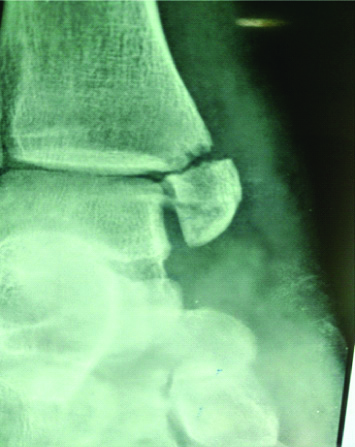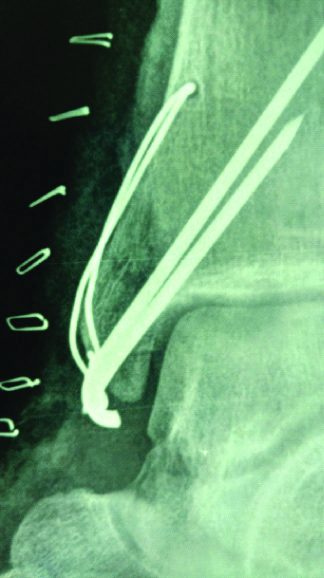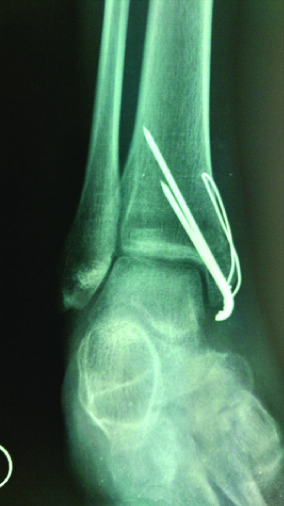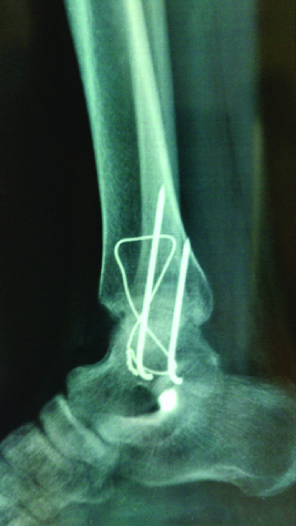A Segmental Medial Malleolus Fracture: A Rare Entity
Anurag Varshney1, Sumedh Manohar Sandanshiv2, Selvamari Mariappan3
1 Senior Resident, Department of Orthopaedics, Postgraduate Institute of Medical Education and Research, Dr. Ram Manohar Lohia Hospital, New Delhi, India.
2 Senior Resident, Department of Orthopaedics, Postgraduate Institute of Medical Education and Research, Dr. Ram Manohar Lohia Hospital, New Delhi, India.
3 Senior Resident, Department of Orthopaedics, Postgraduate Institute of Medical Education and Research, Dr. Ram Manohar Lohia Hospital, New Delhi, India.
NAME, ADDRESS, E-MAIL ID OF THE CORRESPONDING AUTHOR: Anurag Varshney, Senior Resident, Department of Orthopaedics, Postgraduate Institute of Medical Education and Research, Dr. Ram Manohar Lohia Hospital, New Delhi, India.
E-mail: anurag_rog@yahoo.com
Though medial malleolus fracture is very common ankle injury, here the present authors are presenting a very rare segmental medial malleolus fracture in a young person with indefinable mechanism of injury. The present authors aimed to provide a treatment so to achieve perfect anatomical reduction of the ankle mortise and avoid any alteration in mechanism of ankle joint. Open reduction internal fixation and stabilisation with conventional tension band wiring were performed. After six months, patient achieved full range of motion with no pain.
Ankle injury, Fracture, Tension band wiring
Case Report
An 18-year-old male presented to the emergency Department with history of pain, swelling and inability to move right ankle following road traffic accident one day prior to admission. There was no significant medical and surgical history.
On physical examination, the patient was conscious and oriented with stable vitals. On local examination, swelling was present on right ankle medially with no abrasion and bruises. Tenderness was present over medial side of right ankle with painful movement. The position of right ankle at time of injury was not defined. Rest of general and systemic examination revealed no obvious abnormality. Blood counts, liver and kidney function test were within normal limits. However, the ankle radiograph showed isolated segmental fracture of medial malleolus [Table/Fig-1], while chest radiograph was normal.
Fracture Segmental Medial Malleolus of Right Ankle.

Patient was managed with limb elevation, ice pack followed by open reduction internal fixation with conventional tension band wiring passing through both fragments [Table/Fig-2]. After six months of follow-up, fracture was united [Table/Fig-3a,b] and patient was doing well with full range of movement at ankle joint. Patient consent was taken before publishing the case.
Postoperative radiograph of right ankle.

(AP view)-six months post operated fracture with union.

(lateral view)-six months postoperated fracture with union.

Discussion
Ankle fractures are commonly seen in those who play contact sports and also the general population [1]. To identify a fracture and classify the type of injury is important for diagnosis, otherwise considered as occult ligament injuries [2]. Lauge-Hansen system describes many fracture patterns, but all fractures do not fit into a definitive pattern. It is the most common classification for ankle injury based on the position of ankle like adduction, abduction, supination external rotation, pronation external rotation and vertical compression [3-6]. Here the present authors presented an extremely rare segmental fracture of medial malleolus not previously reported in literature yet, as to the best of authors knowledge.
Medial malleolus fracture is the most commonly occurring ankle injury in sports and high velocity ankle twist and trauma injury. The patient history gives an idea about mechanism of injury while diagnosis is confirmed by anteroposterior and lateral radiographs [7]. Undisplaced fracture can be treated conservatively with below knee cast [8], while in case of displacement open reduction internal fixation with tension band wiring [9] or fixation with cancellous screw is a choice [10]. In the index case, fracture pattern was segmental with transverse orientation of fracture fragment. Open reduction internal fixation was done by passing two K-wire through both fragment followed by tension band wiring in traditional way. Fracture was found to be united with full range of motion after six months.
Conclusion
Medial malleolus fractures are most common type of ankle fracture. Although segmental medial malleolus fracture is rare but intervention and outcome are same as unsegmented transverse displaced medial malleolus fracture.
[1]. Clare MP, A rational approach to ankle fracturesFoot Ankle Clin 2008 13:593-10.10.1016/j.fcl.2008.09.00319013398 [Google Scholar] [CrossRef] [PubMed]
[2]. Arimoto HK, Forrester DM, Classification of ankle fractures: an algorithmAJR Am J Roentgenol 1980 135:1057-63.10.2214/ajr.135.5.10576778147 [Google Scholar] [CrossRef] [PubMed]
[3]. Hermans JJ, Beumer A, Mulder PG, Ankle stress test for predicting the need for surgical fixation of isolated fibular fractures: statistical analysisJ Bone Joint Surg Am 2005 87:1885-86.10.2106/00004623-200508000-0003916085636 [Google Scholar] [CrossRef] [PubMed]
[4]. Dabezies E, D’Ambrosia RD, Shoji H, Classification and treatment of ankle fracturesOrthopedics 1978 1:365-73. [Google Scholar]
[5]. Dahners LE, The pathogenesis and treatment of bimalleolar ankle fracturesInstr Course Lect 1990 39:85-94. [Google Scholar]
[6]. Lauge-Hansen N, Fractures of the ankle, II: combined experimental-surgical and experimental-roentgenologic investigationsArch Surg 1950 60:957-85.10.1001/archsurg.1950.0125001098001115411319 [Google Scholar] [CrossRef] [PubMed]
[7]. Ahl T, Dalen N, Selvik G, Ankle fractures: a clinical and roentgenographic stereophotogrammetric studyClin Orthop Relat Res 1989 246:25510.1097/00003086-198908000-00039 [Google Scholar] [CrossRef]
[8]. Hughes JL, Weber H, Willenegger H, Evaluation of ankle fractures: nonoperative and operative treatmentClin Orthop Relat Res 1979 138:111-19. [Google Scholar]
[9]. Ostrum RF, Litsky AS, Tension band fixation of medial malleolus fracturesJ Orthop Trauma 1992 6:464-68.10.1097/00005131-199212000-00013 [Google Scholar] [CrossRef]
[10]. Johnson BA, Fallat LM, Comparison of tension band wire and cancellous bone screw fixation for medial malleolar fracturesJ Foot Ankle Surg 1997 36:284-89.10.1016/S1067-2516(97)80074-9 [Google Scholar] [CrossRef]